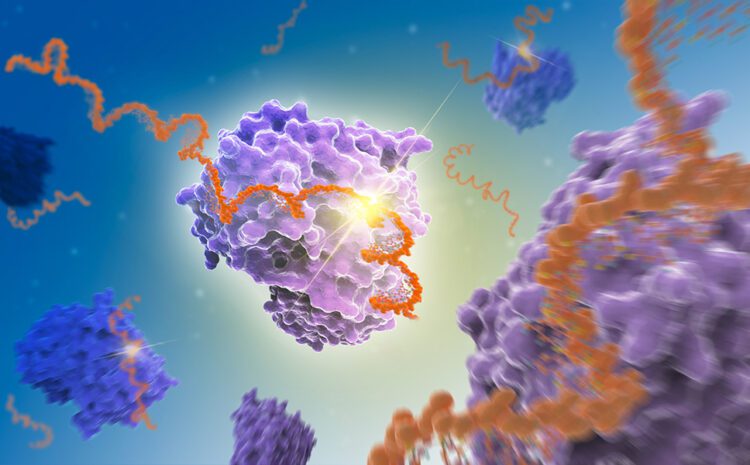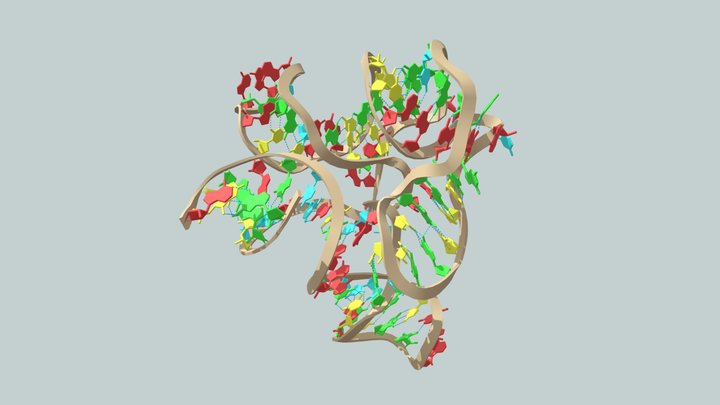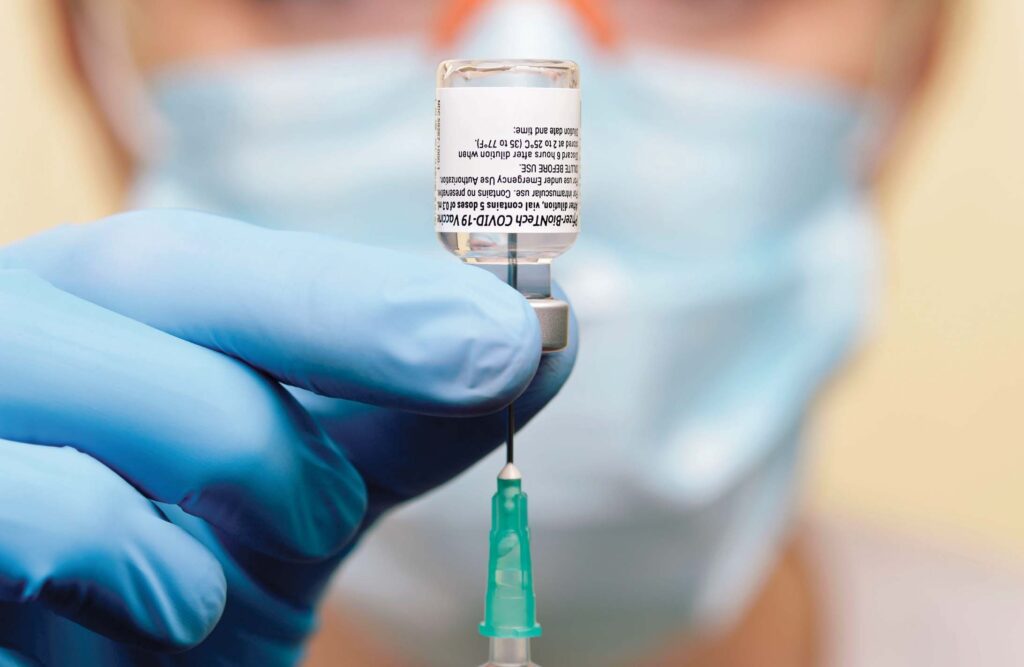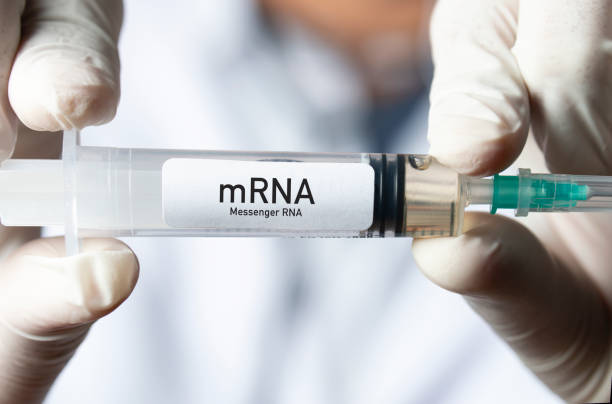
Messenger RNA (mRNA) and Target Viral Proteins
Messenger RNA (mRNA) is a single-stranded nucleic acid involved in synthesizing proteins. During protein synthesis, DNA transcribes to form mRNA called transcription, and other converts to protein by translation. Transcription occurs inside the nucleus, and the mRNA thus formed will enter the cytoplasm, and protein synthesis occurs there.
In protein synthesis, protein-making machinery reads the mRNA sequence and converts each three-base codon into an amino acid in a developing protein chain. mRNA provides the information for producing a protein (peptide) because it transports the data, or message, from the nucleus to the cytoplasm. In other words, mRNA enables the cellular machinery to interpret the DNA-coded human genome. Ribosomes translate information encoded in the mRNA. The DNA code and the machinery that uses DNA to produce proteins need a translator. mRNA is translated DNA that the machinery uses to assemble amino acids into proteins. This connects the code of life to the cell’s ability to build a live entity. mRNA is essential to the creation of the live creature, even though DNA gets more attention in our discussions.
Types of RNA
Prokaryotes and eukaryotes both have three major forms of RNA: messenger RNA (mRNA), ribosomal RNA (rRNA), and transfer RNA (tRNA).
mRNA, also known as messenger RNA, is essential because it serves as a template for forming proteins during translation. tRNA, or transfer RNA, is an integral part of the translation process since it transports amino acids and reads the genetic code. rRNA, also known as ribosomal RNA, is essential to translation operation due to its structural and catalytic roles.
Viral Proteins & Their Significance
Viral structural proteins have many functions beyond building protective casings. These include attachment and entrance, host response regulation, gene expression, and genome replication. Viral ion channels containing 50-120 amino acid membrane proteins regulate virus entrance into the cell, its assembly, and release or host cell subcellular electrochemical equilibrium. These viral proteins control viral structural gene transcription rates. Gene regulation and apoptosis are affected by viral regulatory and auxiliary proteins.
Viruses infiltrate host cells, reproduce their DNA, and create offspring particles by interacting with host cell membranes. Viruses must pass the plasma membrane to reproduce. Wil
Antiviral protein
Human and animal cells generate antiviral proteins that inhibit viral replication in your body as a defensive mechanism. Isolated proteins prevent the virus from reproducing in host cells and spreading to other cells.
Human and animal cells generate antiviral proteins that inhibit viral replication. Isolated proteins prevent the virus from reproducing in host cells and spreading to additional cells. Two key antiviral proteins, Pokeweed and Zinc-Finger, have been tested for viruses, including HIV and influenza.
As per studies, interferons prevent viral infection and suppress cancer growth in laboratory animals.
Capsid
A virus’s protein cap, which encloses its genetic material, is called a capsid. It comprises several protomers, oligomeric (repeating) structural subunits based on proteins. Capsomeres are the observable 3-dimensional morphological subunits, which may or may not correlate to distinct proteins. Capsid proteins or viral coat proteins are the proteins that make up the capsid. The nucleocapsid is the name for the inner genome and the capsid.
Viral envelope or Viral capsids protect their genetic material. Protomers are protein oligomeric structural components. Viral capsids are nanometre-sized containers with sophisticated mechanical features encapsulating, transporting, and releasing the viral DNA in another host cell. The capsid protects and delivers the viral genome to a homologous host cell.
Viruses’ structures vary from host to host. Capsomeres form helical or polyhedral capsids. The capsid protects the nucleic acid from enzymes, attaches the virion to a host cell, and provides proteins to pierce the host cell membrane and inject the infectious nucleic.
For some viruses, the viral proteins that allow the capsid to bind to the host cells are contained within a lipid bilayer surrounding the capsid. The virus envelope is a lipid and protein structure that originates from the host cell membranes. The virus attaches to cells, enters cells, releases the contents of the capsid into the cells, and packages freshly produced viral particles. The capsid and envelope play several roles in viral infection. The capsid and envelope are also responsible for transferring viral genetic material from one cell to another. These structures also determine the stability properties of the viral particle, such as resistance to chemical or physical inactivation.
NS1 protein
NS1 Is a tiny polypeptide, and this influenza virus non-structural protein 1 (NS1) has many functions. NS1 is the major viral antagonist of the innate immune response during influenza virus infection, suppressing the type I interferon system at numerous phases.
Influenza virus NS1 protein fights innate host defense. It is a key immunomodulatory factor that inhibits interferon production and blocks interferon-inducible proteins that limit influenza virus replication.
NS1 tests establish dengue virus infection without serotype information. Negative NS1 tests do not rule out infection. Negative NS1 results should be tested for dengue IgM antibodies to determine recent exposure.

Examples of mRNA vaccines
An mRNA vaccination is a biological material administered in a series of doses to protect you against contracting a disease. mRNA vaccines are now being used to prevent COVID-19 infection. These are the vaccines manufactured by Pfizer and Moderna. They work by inducing your immune system to produce antibodies. Antibodies are proteins that exist in the body. They combat pathogenic bacteria and viruses.
The vaccine’s mRNA instructs your cells to replicate the spike protein. If you are later exposed to the real virus, your body will recognize it and know how to combat it. After the mRNA sends the instructions, your cells degrade and eliminate it.
How mRNA controls Viral proteins ?
Virally encoded RNA polymerase that is packaged inside the virion produces the mRNAs. Enzymes contained within the virion cap methylate the RNA. After that, it is extruded from the capsid’s vertices. The viral proteins produced by the translation of the mRNAs come together to form an immature capsid.
Although viruses encode many of the capabilities needed for viral replication, their ability to replicate depends entirely on the machinery for protein synthesis in their host cells. All viruses require cellular ribosomes to translate viral mRNAs, which is an essential step in the reproduction process.
The pre-mRNA transcript is created by the enzyme RNA polymerase using DNA as a template during transcription. Pre-mRNA undergoes processing to create a mature mRNA molecule, which can then be translated to create the protein molecule (polypeptide) originally encoded by the gene.





